This article has been
cited by other articles in ScienceCentral.
Abstract
Periodontal tissue destroyed by inflammation is difficult to achieve regeneration of the tissue and esthetic restorations only by surgical methods. In particular, improvement of esthetics is more difficult if the problem is related to the implant. A 23 year old woman suffered from unesthetic anterior implant prosthesis. According to her dental history, a repeated bone graft and soft tissue graft failed at a local dental clinic. It was needed to resolve the inflammation and to improve the esthetics. A free gingival graft and ridge augmentation accompanied by guided bone regeneration and a vascularized interpositional periosteal connective tissue graft was performed. Instead of implant prosthesis, a conventional fixed bridge was adopted for better esthetic result. The patient was satisfied with the esthetic conventional fixed prosthesis. This case report introduces esthetic rehabilitation of unesthetic implant prosthetics in the maxillary anterior dentition by a combination of surgical and prosthetic approaches.
Go to :

초록
염증에 의해 파괴된 치주조직은 외과적 방법만으로 조직의 완전한 재생과 심미수복을 이루는 것이 어렵다. 특히, 임플란트와 관련된 문제라면 심미성의 향상을 얻기가 더욱 어렵다. 23세 여자 환자가 비심미적인 전치부 임플란트 보철물을 개선하고자 내원하였다. 개인 치과의원에서 수차례 치조골 이식술과 연조직 이식술을 받았으나 실패한 상태였다. 염증을 제거하고 심미성을 향상시키기 위해 유리치은이식술 시행 후 골유도재생술과 혈관개재 골막결합조직 이식술(vascularized interpositional periosteal connective tissue graft)을 이용한 치조제증대술을 시행하였다. 심미적 보철물 제작을 위해 임플란트 지지형 보철물 대신 인접 자연치를 이용한 전통적인 고정성 보철물을 선택하였다. 상악 전치부 치열에서 비심미적인 임플란트 보철물을 외과적 그리고 보철적 접근을 통한 다각적 방법을 병용함으로써 더 우수한 심미성을 회복한 증례를 소개하고자 한다.
Go to :

Keywords: 치조제 증대술, 임플란트 지지 보철물, 임플란트 주위염
Keywords: alveolar ridge augmentation, implant supported dental prosthesis, peri-implantitis
Introduction
Implant restorations are commonly used for functional and esthetic rehabilitation in missing areas instead of conventional fixed bridges. Despite the high long term success rate of implant prosthesis, implant restorations in the esthetic zone could make some trouble concerning aesthetics and the surgical technique to restore the favorable esthetics is very difficult.
Clinicians often meet a non-esthetic implant restoration in the esthetic zones, and need to be aware of and be capable of handling complications that can lead to the unaesthetic implant restorations. Complications can range from prosthetic problems stemming from a misalignment of implants to biological problems such as failure of guided bone regeneration (GBR), deficiency of soft tissue and peri-implantitis.
1 Lack of an attached gingiva can jeopardize the maintenance of periodontal health and the long term success of dental implants.
2 Many procedures could be used to increase the width and thickness of the attached gingiva. These procedures include an inlay graft, onlay graft, vascularized interpositional periosteal connective tissue graft (VIP-CTG), palatal roll and palatal rotating flap and so on.
3
Peri-implantitis or a misplaced implant without considering the biologic width can cause a loss of bone around the implant.
4 A resective or regenerative surgical treatment could be used depending on the morphology and extent of bone destruction.
5 If the aim of the treatment is to regenerate the surrounding bone, the contaminated implant surface needs to be detoxified in advance and a GBR technique using the barrier membrane and bone substitute could be a more promising and predictable technique.
6 Both resorbable and non-resorbable membranes could be useful for GBR and both have pros and cons respectively. In esthetic sensitive dentition, a resorbable membrane is preferred to avoid additional surgery and decrease the risk of unaesthetic scar formation.
The esthetic problems due to a misplaced implant are often difficult to resolve using only a single approach such as prosthetic or surgical approach. The aim of this study was to present a case of the esthetic rehabilitation of non-esthetic implant prosthetics in the maxillary anterior dentition by a combination of surgical and prosthetic approaches.
Go to :

Case
A 23 year old woman with the chief complaint of non-aesthetics of the maxillary right lateral and central incisors visited the department of periodontology, Pusan national university dental hospital. The patient had no remarkable systemic diseases affecting her dental condition. Her dental history showed that her maxillary right lateral and central incisors had been extracted due to root fracture from an accident when she was 11-year-old. She had a removable provisional prosthesis for a long time because she was growing. Two implants were installed at the maxillary right lateral and central incisors with GBR simultaneously when she was 19-year-old. But gingival bleeding and swelling had occurred repeatedly and was followed by alveolar bone resorption and gingival recession. Therefore, GBR and a soft tissue graft were performed at a local dental clinic 4 times, but the problem concerning esthetics was getting worse and worse.
The maxillary central and lateral incisors had long clinical crowns in comparison with the adjacent natural teeth. The target teeth showed no attached gingiva, deep probing depth and bleeding on probing, and a scar formed in the labial gingiva due to the repeated surgical history (
Fig. 1). On the other hand, these implants were non-mobile. A radiograph showed that the alveolar bone around the implant was resorbed and the paths of the two implants were poor (
Fig. 2). Accordingly, it was diagnosed as peri-implantitis and proposed to require multidisciplinary treatment to resolve the inflammation and to improve the esthetics. First, the resolution of inflammation should be performed first followed by ridge augmentation with GBR and the fabrication of a new esthetic prosthesis.
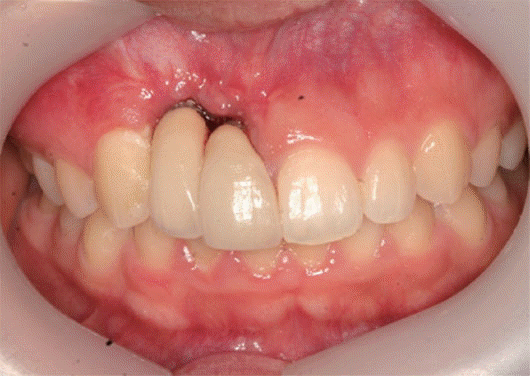 | Fig. 1Initial clinical presentation. Note the long clinical crowns in comparison with the adjacent natural teeth and the inflamed gingiva and scar around the maxillary right lateral and central incisor implants. The area showed a lack of attached gingiva, gingival redness and bleeding tendency. 
|
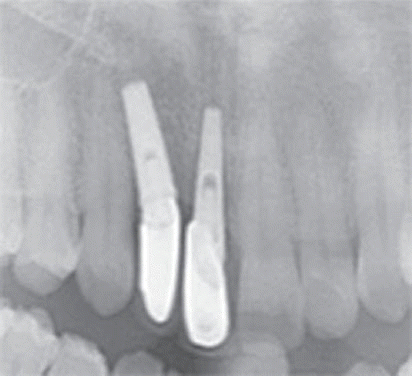 | Fig. 2Initial radiograph showing that the alveolar bone around implants was resorbed and the paths of the two implants were poor. 
|
A free gingival graft (FGG) was performed to increase the amount of attached gingiva (
Fig. 3A). After 4 months, the gingival graft was stabilized and the signs of inflammation disappeared (
Fig. 3B). Improvement in the width and thickness of the soft tissue would be helpful for successful advanced ridge augmentation surgery (
Fig. 3C).
 | Fig. 3Free gingival graft for widening the attached gingiva (A). After 4 months, the gingival graft was stabilized and inflammation was resolved (B). The vertical ridge defect was still observed after a free gingival graft (C). 
|
The patient requested not only healthy soft tissue but also esthetic anterior restorations. Ridge augmentation with GBR had to be preceded in advance to achieve an aesthetic prosthesis and VIP-CTG was planned simultaneously for better soft tissue closure. Ridge augmentation by GBR and VIP-CTG was performed 4 months after FGG. After administering the appropriate local anesthesia in the maxillary anterior area, horizontal sulcular incision and midcrestal incision were made from the maxillary left central incisor to the maxillary right canine. Two vertical incisions were made at the distal of the left central incisor and distal of the right canine. After flap elevation, granulation tissues over the implant surface and the bony defect were removed carefully using a titanium curette (Osung MND, Seoul, Korea) (
Fig. 4A). The implant surfaces were cleaned carefully with cotton pellets soaked sequentially in normal saline and 0.12% chlorhexidine (CHX; Hexamedine®, Bukwang pharm, Seoul, Korea) for detoxification of implant surfaces. They were then washed several times with normal saline and 0.12% CHX. After thorough debridement and implant surface detoxification, the bony defect was augmented with a bovine bone mineral (Bio-Oss, Geistlich, Wolhusen, Swiss) and noncross linked bioresorbable membrane (Bio-Gide, Geistlich) (
Fig. 4B). VIP-CTG was prepared at the ipsilateral palatal area and the graft was anchored at the periosteum of the buccal flap by suturing with absorbable suture material (Vicryl, Ethicon, Johnson and Johnson, New Brunswick, NJ, USA) in advance (
Fig. 4C). The overlying flap was advanced coronally and finally sutured to achieve primary closure (
Fig. 4D). The patient was administered systemic antibiotics (amoxicillin 250mg and metronidazole 250mg three times a day) for one week before surgery and two weeks after surgery. The patient was instructed to avoid mechanical cleaning in the surgical area and to rinse with 0.12% CHX solution twice a day for 14 days. All the sutures were removed at 2 weeks after surgery and healing was uneventful. The patient was recalled at 1 month, 3 months after surgery and the clinical follow-up showed improvement in the ridge deficiency (
Fig. 5A-
D).
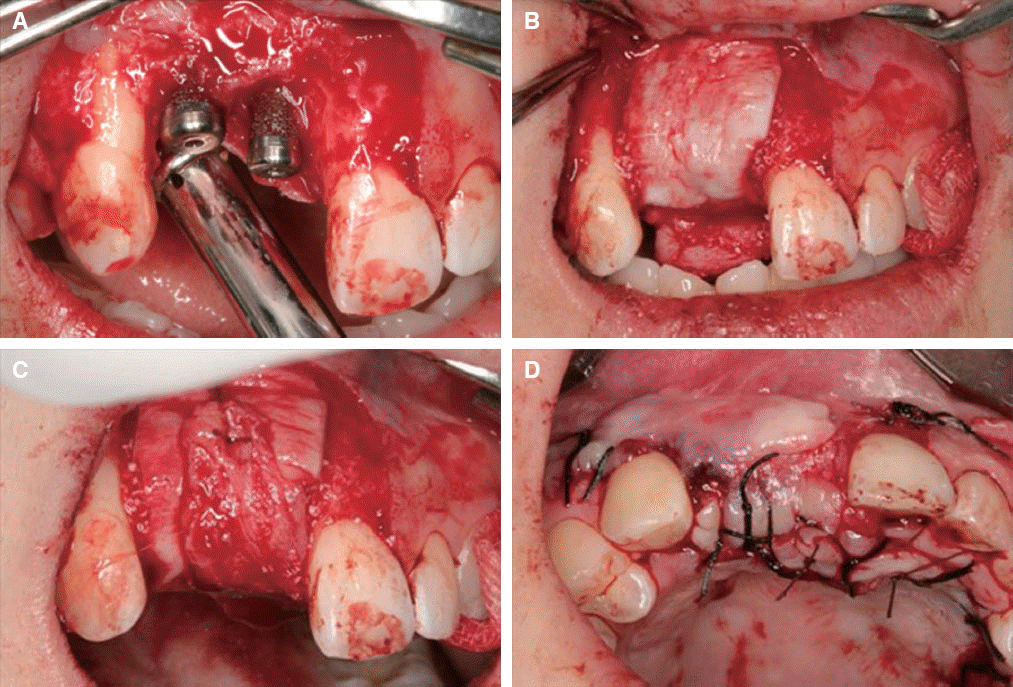 | Fig. 4Ridge augmentation with guided bone regeneration and a vascularized interpositional periosteal connective tissue graft. Note the bony defect around the implants (A). Granulation tissue was removed and the implant surface was detoxified. Bovine bone minerals (Bio-Oss, Geistlich) and non-cross linked bioresorbable membrane (Bio-Gide, Geistlich) was applied (B). Vascularized interpositional periosteal connective tissue graft was rotated over the membrane (C). Overlying flap was sutured for achieving primary closure (D). 
|
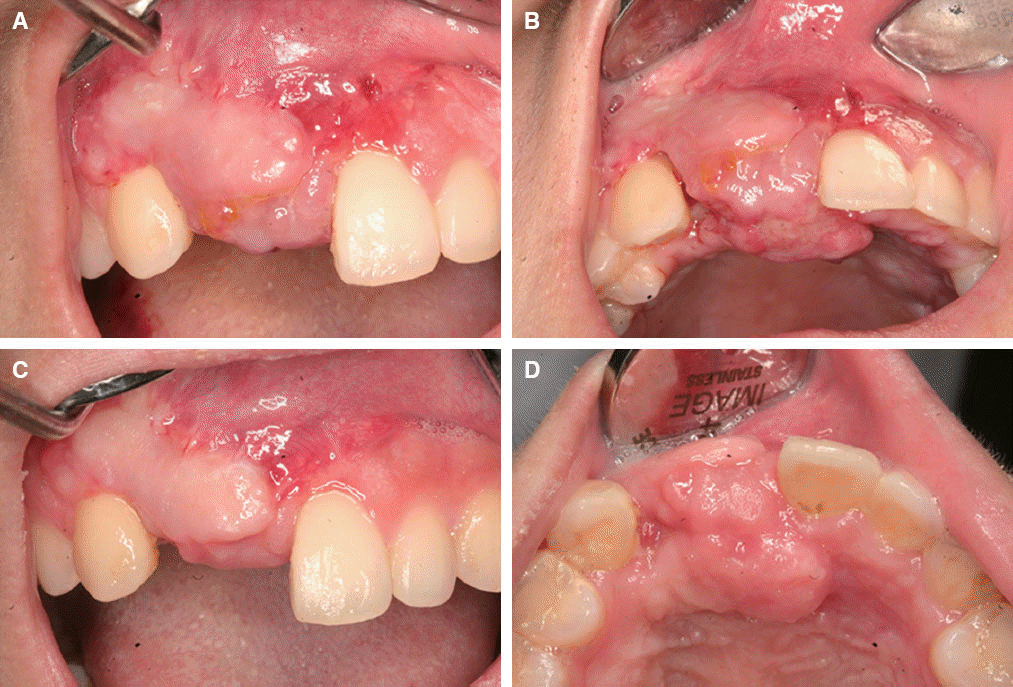 | Fig. 5Clinical follow-up showing the improvement of the ridge deficiency. At stich-out (A, B) and after 1 month (C, D). 
|
Three kinds of prosthetic treatment options were given to the patient at 3 months after ridge augmentation surgery: (1) implant bridge supported by two implants, (2) submergence of the maxillary right lateral incisor implant and the implant cantilever bridge supported by a maxillary right central incisor implant, and (3) submergence of two implants and 4 unit fixed bridge from maxillary right canine and left central incisor. The patient did not adhere to the implant prosthesis and requested the most esthetic restorations. Therefore, Option 3 was chosen because the prosthesis would be more esthetic. A fixed provisional restoration was placed at 3 months after surgery. After a 6-month healing period, the final fixed prosthetic reconstructions were placed (
Fig. 6A-
C). The final prosthesis was an all ceramic restoration (IPS Empress 2, Ivoclar Vivadent, Schaan, Liechtenstein) with a natural appearance in harmony with the adjacent teeth. The gingival tissue around the restoration was healthy and the restoration was esthetic.
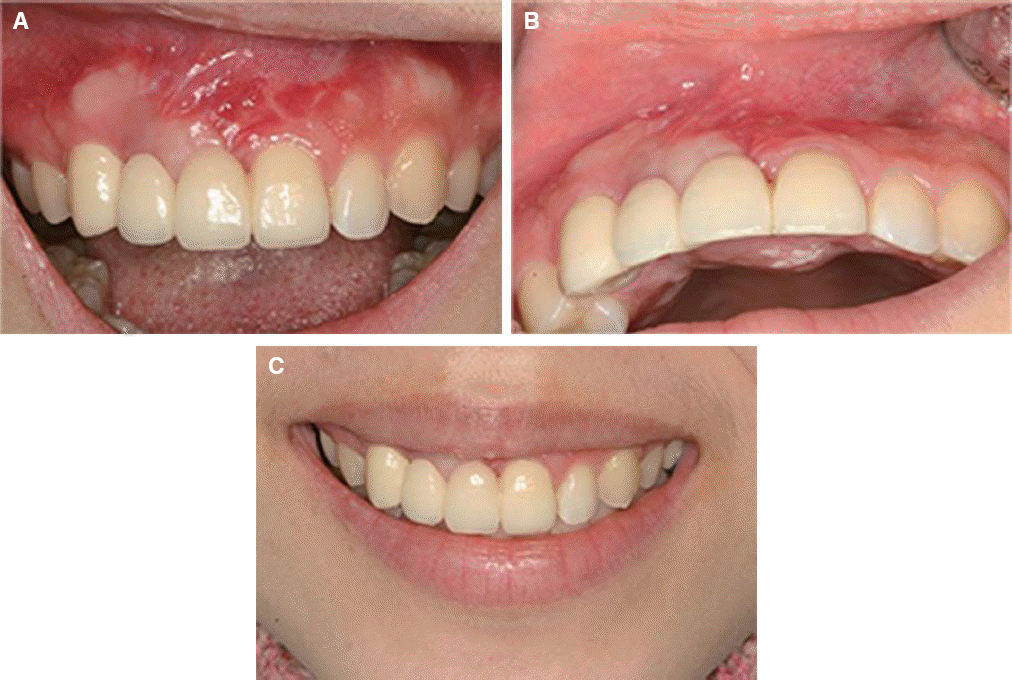 | Fig. 6Final restoration after 6 months of ridge augmentation. Note the natural-looking prostheses in harmony with the adjacent teeth and periodontium reconstructed (A). Occlusal view showed well-reconstructed ridge contour (B). Significant improvements in function, esthetics, and periodontal health were achieved (C). 
|
Go to :

Discussion
Dimensional alteration of the edentulous ridge occurs due to the remodeling of the buccal and lingual walls after extraction. This remodeling process also causes considerable buccal crestal bone loss and problem of esthetics of implant prosthesis.
7 If it takes a long time to place dental implant after extraction, the amount of ridge alteration would be increased.
8 In these cases, the timing of tooth extraction and implant placement should be considered carefully. The extraction site must be preserved as much as possible if you expect a lot of the resorption of alveolar ridge. Forced eruption,
9 socket preservation
9 and root submerge technique
10 could be used to preserve the alveolar ridge and develop a future implant site.
According to the patient’s dental history, a repeated bone graft and soft tissue graft surgery failed. Therefore, the attached gingiva was lost and the implants were surrounded by non-keratinized inflamed tissue. The presence of keratinized mucosal tissue collar around the implants plays a critical role for the longevity of the implant by providing a soft tissue seal that can cope with the bacterial challenge.
2 FGG could be used to correct the soft tissue defects and provide the optimal peri-implant health to increase the long-term prognosis of the implant reconstruction.
11 In this case, after FGG, the gingival inflammation was resolved and an attachment of the implant and the soft tissue was promoted.
A peri-implant bony defect could be restored with a regenerative treatment via GBR with membrane and bone substitute. First, decontamination of the implant surfaces is most important but very difficult to achieve effectively.
12 In particular, the bacteria and plaque biofilm is difficult to remove completely in the rough surface of the implant surface.
13 Many studies have suggested the various implant surface decontamination methods: air-abrasive instrument with glycine,
14 irradiation with an Er:YAG laser,
13 sandblasting,
14 washing with 0.12% CHX and saline,
15 using citric acid, 10% hydrogen peroxide or tetracycline hydrochloride, and cleaning with a cotton pellet soaked in normal saline.
16 As no method is superior, simple and effective methods were adopted, i.e., washing with 0.12% CHX and normal saline and cleaning with cotton pellets soaked in normal saline and 0.12% CHX.
GBR using a barrier membrane and bone graft material showed more favorable clinical and histological results compared to a bone graft alone.
17,
18 Both resorbable and non-resorbable membranes could be useful for peri-implant bone regeneration and both have advantages respectively in special clinical situations. In this case, a resorbable membrane was used to avoid additional surgery and decrease the risk of unaesthetic scar formation because the maxillary anterior dentition is esthetic sensitive area.
For successful ridge augmentation via GBR, sufficient soft tissue volume and primary wound closure were mandatory. A vascularized flap rather than free flap was recommended for reconstruction of the large ridge defect because of preservation of sufficient blood supply. VIP-CTG
19 could be used to correct an aesthetic deficiency and establish stable new peri-implant soft tissue contours as this technique allows the reconstruction of a large soft tissue deficiency, with little constriction postoperatively. Moreover, the VIP-CTG would be useful for achieving the primary soft tissue coverage of the GBR site. In this case, we could reconstruct the large ridge defect using GBR technique combined with VIP-CTG and could achieve the primary flap closure without membrane exposure thanks to VIP-CTG.
It could be an alternative to non-esthetic implant fixed prosthesis and simplify a difficult prosthetic management to rehabilitate with a conventional fixed bridge restoration with submergence of dental implants, so called “sleeping” implants.
20 It is important not to overlook the fact that a conventional fixed bridge is a more predictable form of aesthetic prosthesis.
Go to :

Conclusion
Perfect aesthetics of implant fixed prosthesis is difficult to achieve in the esthetic zone. Moreover, it is more difficult to correct the serious problem of a non-esthetic implant prosthesis using only a surgical or prosthetic approach. Therefore, a multidisciplinary approach using the surgical and prosthetic methods could be useful to enhance the aesthetics of non-esthetic implant prosthesis.
Go to :

Orcid
Go to :

Acknowledgements
This study was supported by Clinical Research Grant from Pusan National University Dental Hospital (2015).
Go to :

References
1. Froum SJ, Rosen PS. A proposed classification for peri-implantitis. Int J Periodontics Restorative Dent. 2012; 32:533–40. PMID:
22754901.
2. Wennström JL, Bengazi F, Lekholm U. The influence of the masticatory mucosa on the periimplant soft tissue condition. Clin Oral Implants Res. 1994; 5:1–8. DOI:
10.1034/j.1600-0501.1994.050101.x. PMID:
8038340.
3. Le B, Burstein J. Esthetic grafting for small volume hard and soft tissue contour defects for implant site development. Implant Dent. 2008; 17:136–41. DOI:
10.1097/ID.0b013e318174db99. PMID:
18545044.
4. Jovanovic SA. The management of peri-implant breakdown around functioning osseointegrated dental implants. J Periodontol. 1993; 64:1176–83. DOI:
10.1902/jop.1993.64.11s.1176. PMID:
8295108.
5. Lindhe J, Meyle J. Group D of European Workshop on Periodontology Peri-implant disease: Consensus Report of the Sixth European Workshop on Periodontology. J Clin Periodontol. 2008; 35:282–5. DOI:
10.1111/j.1600-051X.2008.01283.x. PMID:
18724855.
6. Heitz-Mayfield LJ, Mombelli A. The therapy of peri-implantitis: a systematic review. Int J Oral Maxillofac Implants. 2014; 29:325–45. DOI:
10.11607/jomi.2014suppl.g5.3. PMID:
24660207.
8. Buser D, Martin W, Belser UC. Optimizing esthetics for implant restorations in the anterior maxilla: anatomic and surgical considerations. Int J Oral Maxillofac Implants. 2004; 19:43–61. PMID:
15635945.
9. Salama H, Salama M. The role of orthodontic extrusive remodeling in the enhancement of soft and hard tissue profiles prior to implant placement: a systematic approach to the management of extraction site defects. Int J Periodontics Restorative Dent. 1993; 13:312–33. PMID:
8300319.
10. Harper KA. Submerging an endodontically treated root to preserve the alveolar ridge under a bridge-a case report. Dent Update. 2002; 29:200–3. PMID:
12050887.
13. Kreisler M, Kohnen W, Christoffers AB, Götz H, Jansen B, Duschner H, d’Hoedt B. In vitro evaluation of the biocompatibility of contaminated implant surfaces treated with an Er: YAG laser and an air powder system. Clin Oral Implants Res. 2005; 16:36–43. DOI:
10.1111/j.1600-0501.2004.01056.x. PMID:
15642029.
14. Singh G, O’Neal RB, Brennan WA, Strong SL, Horner JA, Van Dyke TE. Surgical treatment of induced peri-implantitis in the micro pig: clinical and histological analysis. J Periodontol. 1993; 64:984–9. DOI:
10.1902/jop.1993.64.10.984. PMID:
8277409.
15. Wetzel AC, Vlassis J, Caffesse RG, Hämmerle CH, Lang NP. Attempts to obtain re-osseointegration following experimental peri-implantitis in dogs. Clin Oral Implants Res. 1999; 10:111–9. DOI:
10.1034/j.1600-0501.1999.100205.x. PMID:
10219130.
16. Froum SJ, Froum SH, Rosen PS. Successful management of peri-implantitis with a regenerative approach: a consecutive series of 51 treated implants with 3- to 7.5-year follow-up. Int J Periodontics Restorative Dent. 2012; 32:11–20. PMID:
22254219.
17. Hürzeler MB, Quiñones CR, Morrison EC, Caffesse RG. Treatment of peri-implantitis using guided bone regeneration and bone grafts, alone or in combination, in beagle dogs. Part 1: Clinical findings and histologic observations. Int J Oral Maxillofac Implants. 1995; 10:474–84. PMID:
7672851.
18. Hürzeler MB, Quiñones CR, Schüpback P, Morrison EC, Caffesse RG. Treatment of peri-implantitis using guided bone regeneration and bone grafts, alone or in combination, in beagle dogs. Part 2: Histologic findings. Int J Oral Maxillofac Implants. 1997; 12:168–75. PMID:
9109266.
19. Sclar AG. Sclar AG, editor. The vascularized interpositional periosteal-connective tissue (VIP-CT) flap. Soft tissue and esthetic considerations in implant therapy. 2003. Florida: Quintessence;p. 205–21.
20. Poqqio CE, Salvato A. Implant repositioning for esthetic reasons: a clinical report. J Prosthet Dent. 2001; 86:126–9. DOI:
10.1067/mpr.2001.117054. PMID:
11514796.
Go to :







 PDF
PDF Citation
Citation Print
Print






 XML Download
XML Download